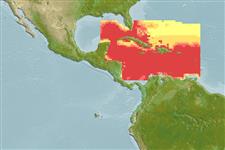Environment: milieu / climate zone / depth range / distribution range
Ecología
marino; oceanodromo (Ref. 51243). Subtropical; 28°N - 10°N, 90°W - 60°W (Ref. 189)
Western Central Atlantic: Florida Keys, Cuba, Bahamas, Antilles, Los Roques Archipelago off Venezuela; from Yucatan, Mexico possibly to western Venezuela; not in Gulf of Mexico. If correctly identified, then it occurs in Sibun River, Belize.
Tamaño / Peso / Age
Maturity: Lm ? range ? - ? cm
Max length : 11.0 cm TL macho / no sexado; (Ref. 5217); common length : 8.0 cm TL macho / no sexado; (Ref. 5217)
Espinas dorsales (total): 0; Espinas anales 0; Radios blandos anales: 21 - 26. Body somewhat compressed and slender. Snout less than eye diameter; maxilla long, tip pointed, reaching almost to gill opening; gill cover canals of walkeri-type. Anal fin moderately long, its origin below about midpoint of dorsal fin base. A silver stripe along flank, a little less than eye diameter (Ref. 189). Melanophores on underside of snout do not reach premaxillae, leaving an unpigmented area (Ref. 7251).
A schooling fish, apparently preferring clear oceanic waters.
Life cycle and mating behavior
Madurez | Reproducción | Puesta | Huevos | Fecundidad | Larva
Spawn in school (Ref. 205).
Whitehead, P.J.P., G.J. Nelson and T. Wongratana, 1988. FAO Species Catalogue. Vol. 7. Clupeoid fishes of the world (Suborder Clupeoidei). An annotated and illustrated catalogue of the herrings, sardines, pilchards, sprats, shads, anchovies and wolf-herrings. FAO Fish. Synop. 125(7/2):305-579. Rome: FAO. (Ref. 189)
IUCN Red List Status (Ref. 130435)
Threat to humans
Harmless
Human uses
Pesquerías: escaso valor comercial; carnada: usually
Más información
ReferenciasAcuiculturaPerfil de acuiculturaRazasGenéticaElectrophoresesheritabilidadEnfermedadesProcesamientoNutrientsMass conversion
ColaboradoresImágenesStamps, Coins Misc.SonidosCiguateraVelocidadTipo de nataciónSuperficie branquialOtolitosCerebrosVisión
Herramientas
Special reports
Download XML
Fuentes de Internet
Estimates based on models
Preferred temperature (Ref.
123201): 18.1 - 27.4, mean 23.2 °C (based on 63 cells).
Phylogenetic diversity index (Ref.
82804): PD
50 = 0.5000 [Uniqueness, from 0.5 = low to 2.0 = high].
Bayesian length-weight: a=0.00513 (0.00232 - 0.01135), b=3.14 (2.96 - 3.32), in cm total length, based on LWR estimates for this Genus-body shape (Ref.
93245).
Nivel trófico (Ref.
69278): 3.3 ±0.4 se; based on size and trophs of closest relatives
Resiliencia (Ref.
120179): Alto, población duplicada en un tiempo mínimo inferior a 15 meses (Preliminary K or Fecundity.).
Fishing Vulnerability (Ref.
59153): Low vulnerability (10 of 100).
